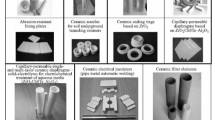Abstract
The effect of various additives on the process of structure formation in ceramics is investigated. The functions of additives at different stages of heat treatment of ceramic mixtures are studied. The possibility of producing articles with prescribed properties is established.
Similar content being viewed by others
REFERENCES
V. F. Pavlov, Physicochemical Principles of Firing Construction Ceramic Articles [in Russian], Stroiizdat, Moscow (1976).
G. N. Maslennikova, Ceramic Materials [in Russian], Stroiizdat, Moscow (1991).
V. D. Beshentsev, “Properties of feldspar melts with additives,” Neorg. Mater., 22(4), 636–639 (1986).
A. M. Eminov and A. K. Abdurakhmanov, “Sintering of Angrenskoe clay with a high content of montmorillonite,” Uzb. Khim. Zh., No. 1, 54–55 (1989).
A. M. Eminov and A. K. Abdurakhmanov, “On the mechanism of structure formation in slag-containing ceramic material,” Uzb. Khim. Zh., No. 6, 7–10 (1997).
G. N. Maslennikova, I. Kh. Moroz, and S. A. Dubovitskii, “Intensification of the process of porcelain formation by introducing a complex additive,” Steklo Keram., No. 9, 18–19 (1985).
V. P. Nebera, Flocculation of Mineral Suspensions [in Russian], Nedra, Moscow (1983).
Author information
Authors and Affiliations
Rights and permissions
About this article
Cite this article
Abdurakhmanov, A.K., Éminov, A.M. & Maslennikova, G.N. Stages of Ceramic Structure Formation in the Presence of Additives. Glass and Ceramics 57, 354–356 (2000). https://doi.org/10.1023/A:1007150606044
Issue Date:
DOI: https://doi.org/10.1023/A:1007150606044




